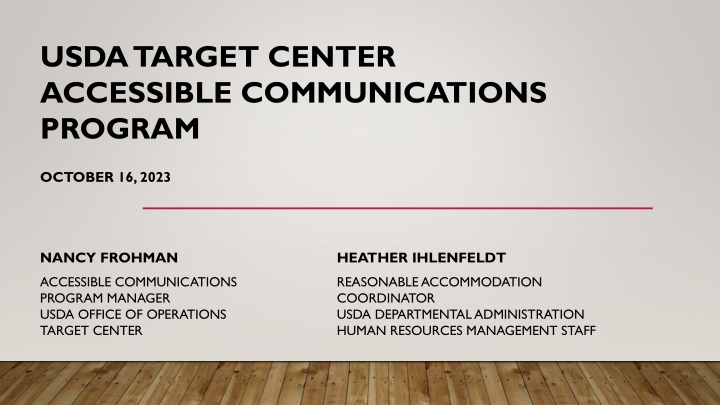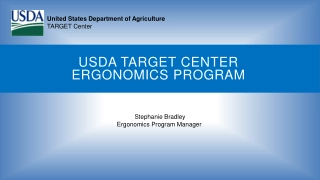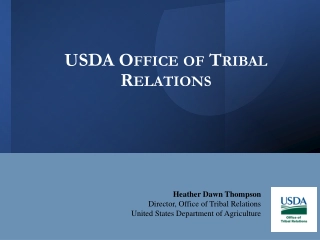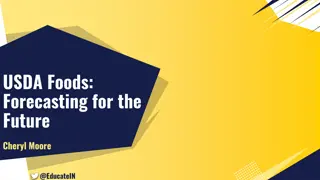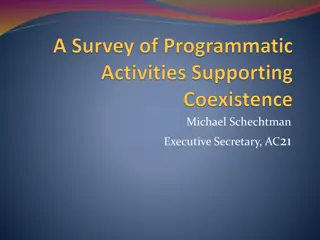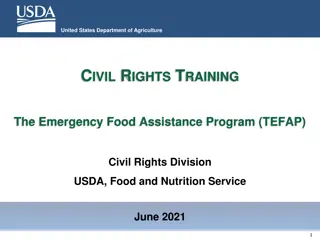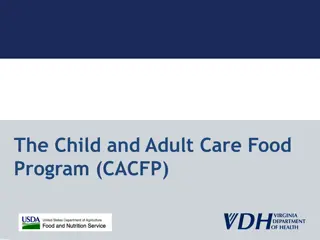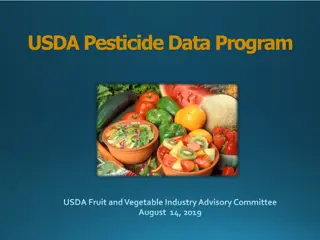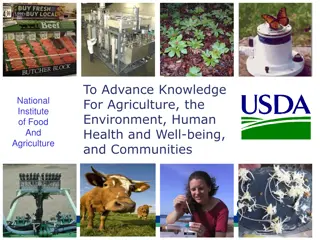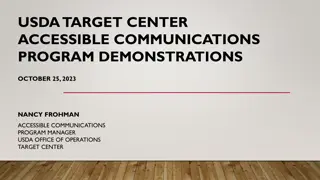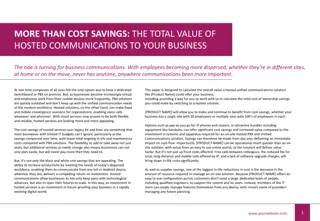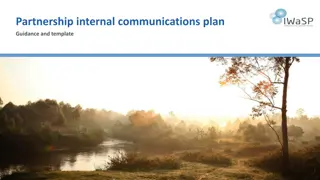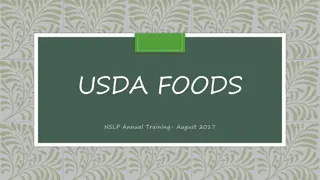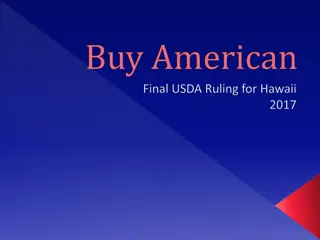USDA Accessible Communications Program Overview
Advancing access and equity for individuals with disabilities is a key focus of the USDA Accessible Communications Program. Through initiatives like the National Disability Employment Awareness Month events and implementing the Rehabilitation Act, the program aims to promote accessible communication for all. The program emphasizes learning objectives such as understanding communication barriers, recognizing the importance of accessible communication, and adhering to USDA's Departmental Regulations. Communication access is defined as the ability to send, receive, and comprehend messages through various symbol systems. Providing accessible communication benefits individuals with sensory disabilities by fostering equal participation in informational exchange. The USDA Office of DEIA highlights the significance of offering clear and easy-to-understand information to diverse audiences. Identification of individuals requiring communication access includes those with vision, hearing, speech, and cognitive disabilities across different USDA stakeholders and service centers nationwide.
Download Presentation

Please find below an Image/Link to download the presentation.
The content on the website is provided AS IS for your information and personal use only. It may not be sold, licensed, or shared on other websites without obtaining consent from the author.If you encounter any issues during the download, it is possible that the publisher has removed the file from their server.
You are allowed to download the files provided on this website for personal or commercial use, subject to the condition that they are used lawfully. All files are the property of their respective owners.
The content on the website is provided AS IS for your information and personal use only. It may not be sold, licensed, or shared on other websites without obtaining consent from the author.
E N D
Presentation Transcript
USDA TARGET CENTER ACCESSIBLE COMMUNICATIONS PROGRAM OCTOBER 16, 2023 NANCY FROHMAN HEATHER IHLENFELDT ACCESSIBLE COMMUNICATIONS PROGRAM MANAGER USDA OFFICE OF OPERATIONS TARGET CENTER REASONABLE ACCOMMODATION COORDINATOR USDA DEPARTMENTAL ADMINISTRATION HUMAN RESOURCES MANAGEMENT STAFF
ADVANCING ACCESS & EQUITY National Disability Employment Awareness Month of 2023 Celebrating 50 years of the Rehabilitation Act of 1973!
LEARNING OBJECTIVES 1. Importance of accessible communication and identifying those who need it. 2. Learn the factors that lead to communication barriers. 3. Gain an understanding of USDA s Departmental Regulations.
COMMUNICATION IS THE ABILITY TO Receive, Send, Process, Comprehend concepts, or verbal, nonverbal and graphic symbol systems.
COMMUNICATION ACCESS People with sensory disabilities can communicate (and be communicated with) on an equal footing with those who do not have such disabilities. To receive and share information is essential to learn, exchange ideas, express feelings and form relationships. No communication barriers.
Executive Order on Diversity, Equity, Inclusion, and Accessiblity in the Federal Workforce (DEIA). SIGNIFICANCE OF PROVIDING ACCESSIBLE COMMUNICATIONS USDA Office of DEIA. Benefits all audiences by making information clear, direct and easy to understand.
Receive opportunities for feedback and experiences on various barriers to accessing information. SIGNIFICANCE OF PROVIDING ACCESSIBLE COMMUNICATIONS (CONT.) Diverse and inclusion. Increase your customers. Hire new employees. Do the right thing.
IDENTIFICATION REQUIRING COMMUNICATION ACCESS USDA individuals with disabilities, including those with vision, hearing, communication, and cognitive disabilities. USDA employees, customers, job applicants, visitors, farmers, firefighters, rangers, private landowners, land managers, and small business customers. USDA Service Centers in the NCR and Nationwide.
FACTORS CONTRIBUTING TO COMMUNICATION BARRIERS VISION HEARING COMMUNICATION COGNITION
VARIETIES OF VISION DISABILITIES Blind. Near-Sighted. DeafBlind. Partially Sighted. Far-Sighted. People with Vision Loss. Legally Blind. Totally Blind. Low Vision.
Provide braille, large prints or audio. Give a clear word picture when describing things to an individual with vision loss. Include details such as color, texture, shape and landmarks. EFFECTIVE COMMUNICATIONS ACCESS FOR VISION Use their name when addressing them, it lets them know you are speaking to them, not someone else in the room. Identify the details of the room when in presence with audio.
Provide assistive technology such as screen magnification and/or speech reading for utilizing the computer and mobile devices. EFFECTIVE COMMUNICATIONS ACCESS FOR VISION (CONT.) Provide audio that contains the same information as documents you provided. Audio/video description. Availability of reasonable accommodation(s) on event and training announcements.
VARIETIES OF HEARING DISABILITIES Deaf. Low Vision and Deaf. Hard of Hearing. Low Vision and Hard of Hearing. Hearing Loss. DeafBlind. Late-Deafened.
Qualified Service Providers: American Sign Language Interpreters. EFFECTIVE COMMUNICATIONS ACCESS FOR HEARING CART Captioners. TypeWell/Notetakers. Other types of service providers, such as Oral, Cued-Speech, Tactile Interpreters, etc. Captions.
Networking speed for the high-quality videophone calls. EFFECTIVE COMMUNICATIONS ACCESS FOR HEARING (CONT.) Video Relay Service (VRS). Voice to text transcription applications. Chat. Internet captioned telephone service. Written or printed content.
Face to face, eye contacts. One on one, not group. EFFECTIVE COMMUNICATIONS ACCESS FOR HEARING (CONT.) Lighting settings. Do not cover your mouth. Gesture. Rephrase.
Digital accessibility. EFFECTIVE COMMUNICATIONS ACCESS FOR HEARING (CONT.) Agenda for meetings in advance for customers and service providers. Availability of reasonable accommodation(s) on event and training announcements.
THREE MAJOR TYPES OF COMMUNICATION DISABILITIES Articulation. Fluency. Voice.
Give the person more time. Qualified Speech to Speech Transliterator. EFFECTIVE COMMUNICATIONS ACCESS FOR COMMUNICATION DISABILITIES Check that you have their attention before talking. Reduce background noise and distractions. Use short sentences and familiar words
Emphasize the key word or small group of words. EFFECTIVE COMMUNICATIONS ACCESS FOR COMMUNICATION DISABILITIES (CONT.) Communicate clearly and slowly and use an appropriate. Tone. Be patient.
VARIETIES OF COGNITIVE DISABILITIES Intellectual disability. Autism spectrum disorders. Mental health. Brain injury. Stroke. Types of dementias.
Use clear and simplified language. Avoid using technical language. EFFECTIVE COMMUNICATIONS FOR COGNITIVE DISABILITIES Avoid using long words with many syllables. Rephrase your sentence. Allow them to think and answer. Be patient.
Purpose. EVALUATION ON COMMUNICATION ACCESS IN THE SERVICE AREAS Form. Identify and recommendations. Solutions.
RESPONSIBILITIES FOR PROVIDING ACCESSIBLE COMMUNICATIONS Mission Areas, Agencies, and Staff Offices. National Capital Region (NCR). Nationwide.
Rehabilitation Act of 1973. Americans with Disabilities Act Amendments Act of 2008 (ADAAA). REQUIREMENTS AND RESPONSIBILITIES ON REASONABLE ACCOMMODATIONS (RA) Departmental Regulation (DR 4300-008): Reasonable Accommodations (RA) and Personal Assistance Services (PAS) for Employees and Applicants with Disabilities. Mission Areas, Agencies, or Staff Offices have the responsibilities to provide and fund the RA.
RA PROCEDURES RA Contacts on the TARGET Center Website: https://www.usda.gov/target- center/topics/ra-list Contact your RA Coordinator in your Mission Area, Agency or Staff Office. Reasonable Accommodations Coordinators and Supervisors: Importance of collaboration. Approval and funding.
CURRENT AND UPCOMING MEETINGS OCTOBER MONDAY WEDNESDAY THURSDAY TUESDAY 10/17/2023 10/17/2023 10/18/2023 10/16/2023 11:00 AM 12:00 PM Unmasking Hidden Challenges: Chronic Conditions in the Workplace Dr. Theresa Haskins Haskins Consulting 10:00 AM 11:00 AM Ergonomic Equity: Addressing Risk Factors Through Job Analysis and Prevention Sandra Miller Britroix 11:00 AM 12:00 PM USDA TARGET Center Accessible Communications Program Nancy Frohman Accessible Communications Program Manager 12:00 PM 1:00 PM Digital Accessibility Fundamentals for Websites, Documents, and Video Mike Caprara The Viscardi Center 1:00 PM 2:00 PM Equity, Accessibility, and Inclusion in the Workplace (Part 1 of 2) Dr. Theresa Haskins Haskins Consulting 10/25/2023 10/24/2023 10/23/2023 10/26/2023 10/25/2023 11:00 AM 12:00 PM Thriving with ADHD at Work Dr. Theresa Haskins Haskins Consulting 11:00 AM 12:00 PM Emotional Intelligence (Part 1 of 2) Carolyn Owens, MCC, SPHR 10:00 AM 11:00 AM Assistive Technology at New Heights Dr. Wayne Crolley Novare Products, LLC 10:00 AM - 12:00 PM USDA TARGET Center Accessible Communications Demonstrations (Virtual/Onsite) Nancy Frohman Accessible Communications Program Manager 1:00 PM 2:00 PM Equity, Accessibility, and Inclusion in the Workplace (Part 2 of 2) Dr. Theresa Haskins Haskins Consulting 1:00 PM 2:00 PM Proper Posture in the Workplace to Prevent Posture-Related Problems (Part 1 of 2) Dr. Krista Burns American Posture Institute
CONTACT INFORMATION TARGET Center Website https://www.usda.gov/target-center TARGET Center Email target-center@usda.gov TARGET Center Phone Number (202) 720-2600
